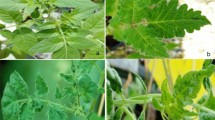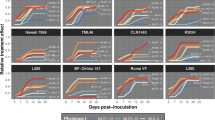Summary
One hundred eighty-eight accessions of Lycopersicon cheesmanii, L. chilense, L. chmielewskii, L. hirsutum, L. parviflorum, L. pennellii, and L. peruvianum were screened for resistance to three isolates of tomato spotted wilt virus (TSWV). All plants in an accession were initially screened for resistance to TSWV using isolate 85–9 from Arkansas. Visual symptoms were used to cull obviously infected plants, followed by enzyme-linked immunosorbent assay (ELISA) to identify uninfected plants. Cuttings were taken from uninfected plants in the first screening and the resulting plants were inoculated with isolates Glox and T-2 from Texas and Hawaii, respectively. No resistance was identified in L. cheesmanii, L. chmielewskii, L. hirsutum, L. parviflorum, and L. pennellii. However, 33 of 63 L. chilense accession produced 91 of 1268 plants that were uninfected with isolate 85–9 and 20 accessions that produced 40 of 257 plants that were not infected with any of the isolates. After screening with isolate 85–9 9 of 12 L. peruvianum accessions tested had 38 plants uninfected and 8 accessions had 25 plants that were not infected with any of the isolates.
Similar content being viewed by others
References
Araújo, M.T.,A.C. de Ávila,F.P. Cupertino & W.R. Maluf, 1983. Lycopersicon hirsutum nova fonte de resistência ao vírus do viracabeca (TSWV). In: Congresso Brasileiro de Olericultura, 23, Resumos. Rio de Janeiro. 164.
Best, R.J., 1968. Tomato spotted wilt virus. Adv. Virus. Res. 13: 65–146.
Boiteux, L.S. & L. de B., Giordano, 1992. Screening Lycopersicon germplasm for resistance to a Brazilian isolate of spotted wilt virus (TSWV). Rep. Tomato Genet. Coop. 42: 13–14.
Boiteux, L.S., T., Nagata & L. de B., Giordano, 1993. Field resistance of tomato Lycopersicon esculentum lines to tomato spotted wilt disease. Rep. Tomato Genet. Coop. 43: 7–9.
Brittlebank, C.C., 1919. Tomato diseases. J. Dept. Agric. Victoria 27: 231–235.
Cho, J.J., R.F.L., Mau, T.L., German, R.W., Hartmann, L.S., Yudin, D., Gonsalves & R., Provvidenti, 1989. A multidisciplinary approach to management of tomato spotted wilt virus in Hawaii. Plant Dis. 73: 375–383.
Cho, J.J., R.F.L., Mau,D., Gonsalves & W.C., Mitchell, 1986. Reservoir weed hosts of tomato spotted wilt virus. Plant Dis. 70: 1014–1017.
Cho, J.J., R.F.L. Mau, W.C. Mitchell, D. Gonsalves & L.S. Yudin, 1987. Host list of plants susceptible to tomato spotted wilt virus (TSWV). Univ. Hawaii Coll. Trop. Agric. Hum. Resour. Res. Ext. Ser. 078.
Cupertino, F.P., A.C., Avila, M.T., Araújo & W.R., Maluf, 1986. Fontes de resistência ao virus de vira-cabeça em Lycopersicon. Fitopatologia Brasileira 11: 330.
Finlay, K.W., 1952. Inheritance of spotted wilt virus resistance in the tomato. I. Identification of strains of the virus by the resistance or susceptibility of tomato species. Aust. J. Sci. Res. 5: 303–314.
Finlay, K.W., 1953. Inheritance of spotted wilt resistance in the tomato. II. Five genes controlling spotted wilt resistance in four tomato types. Aust. J. Biol. Sci. 6: 153–163.
German, T.L., D.E., Ullman & J.W., Moyer, 1992. Tospoviruses: Diagnosis, molecular biology, phylogeny, and vector relationships. Annu. Rev. Phytopathol. 30: 315–348.
gilbert, J.C. & J.S., Tanaka, 1971. ‘Anahu’, an outstanding hybrid maker. Hawaii Farm Sci. 20: 6–7.
Holmes, F.O., 1948. Resistance to spotted wilt in tomato. Phytopathology 38: 467–473.
Iizuka, N., L.S., Boiteux, L. de B., Giordano, T., Nagata & A.N., Dusi, 1993. Sources of resistance to spotted wilt virus (TSWV) in wild Lycopersicon species. Rep. Tomato Genet. Coop. 43: 20–22.
Kikuta, K., J.W. Hendrix & W.A. Frazier, 1945. ‘Pearl Harbor’, a tomato variety resistant to spotted wilt in Hawaii. Univ. of Hawaii Agr. Exp. Sta. Circ. 24.
Kikuta, K. & W.A., Frazier, 1946. Breeding tomatoes for resistance to spotted wilt in. Hawaii. Proc. Amer. Soc. Hort. Sci. 47: 241–276.
Lasa, C.I., 1983.Respuesta de diez cultivares de tomate al virus de la peste negra (TSWV). Investigaciones Agronómicas 4: 6–10.
Maluf, W.R., M., Toma-Braghini & R.D., Corte, 1991. Progress in breeding tomatoes for resistance to tomato spotted wilt. Brazil. J. Genetics 14: 509–525.
Norris, D.O., 1946. The strain complex and symptom variability of tomato spotted wilt virus. Aust. Coun. Sci. Ind. Res. Bull. 202.
Paterson, R.G., S.J., Scott & R.C., Gergerich, 1989. Resistance in two Lycopersicon species to an Arkansas isolate of tomato spotted wilt virus. Euphytica 43: 173–178.
Rick, C.M., 1988. Molecular markers as aids for germplasm management an and use in Lycopersicon. HortScience 23: 55–57.
Samuel, G., J.G. Bald & H.A. Pittman, 1930. Investigations on spotted wilt of tomatoes. Aust. Council Sci. Ind. Res. Bull. 44.
Smith, P.G., 1944. Reaction of Lycopersicon spp. to spotted wilt. Phytopathology 34: 504–505.
Stevens, J.M., 1964. Tomato breeding. Project Report W-Vv1, Dept. Agricultural Technical Services. Republic of South Africa.
Stevens, M.R., 1993. Studies on inheritance of resistance to tomato spotted wilt virus in the genus Lycopersicon. Ph.D. Thesis. University of Arkansas, Fayetteville, Arkansas, USA.
Stevens, M.R., S.J., Scott & R.C., Gergerich, 1992. Inheritance of a gene for resistance to tomato spotted wilt virus (TSWV) from Lycopersicon peruvianum Mill. Euphytica 59: 9–17.
Sutula, C.L., J.M., Gillett, S.M., Morrissey & D.C., Ramsdell, 1986. Interpreting ELISA data and establishing the positive-negative threshold. Plant Dis. 70: 722–726.
Upreti, G. & R.W., Hartmann, 1984. Inheritance of resistance to spotted wilt virus in tomato. J. Inst. Agric. Anim. Sci. 4: 19–25.
van, Zijl, J.J.B., S.E., Bosch & C.P.J., Coetzee, 1986. Breeding tomatoes for processing in South Afrca. Acta Hort. 194: 69–75.
Wenholz, H., 1939. Spotted wilt of tomatoes: breeding for resistance. Hawkesbury Agric. Coll. J. 36: 103. In: Plant Breeding Abstr. 10:
Watterson, J., C. Wyatt, J. Cho & D. Custer, 1989. Inheritance of tomato spotted wilt resistance in tomato. International Society of Horticultural Science Vegetable Virus Working Group. 6th Conference: Recent Advances in Vegetable Virus Research.
Author information
Authors and Affiliations
Rights and permissions
About this article
Cite this article
Stevens, M.R., Scott, S.J. & Gergerich, R.C. Evaluation of seven Lycopersicon species for resistance to tomato spotted wilt virus (TSWV). Euphytica 80, 79–84 (1994). https://doi.org/10.1007/BF00039301
Received:
Accepted:
Issue Date:
DOI: https://doi.org/10.1007/BF00039301




